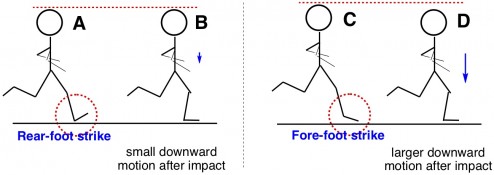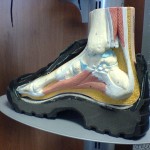
"Barefoot" (minimalist) shoes
The much anticipated New York Marathon took place yesterday. News articles leading up to the event tended to focus on who would be runninge.g., Jared from Subway and Edison Pena from the Chilean mine, but at least one article hit on a somewhat controversial (and scientific!) topic in the running community – the barefoot running/minimalist shoe trend. Though some supporters of minimalist footwear are compelled by a vague sense of bare feet being “more natural”, there is actually some legitimate science to back up their preference. This science was published several months ago, but it is worth taking a look at it now, as the 2010 fall marathon season nears its close.
A technical paper was published earlier this year in Nature providing evidence that the form typically adopted by barefoot runners results in a significant softening of impact on the body, potentially reducing the risk of impact-related injuries. Lieberman et al. observed and videotaped the feet of athletes running at an endurance pace (i.e., a speed sustainable for a long distance, not a sprint). The athletes were either from the U.S. or Kenya, and included both runners that habitually ran wearing shoes and ones that were used to running barefoot. The researchers found that different runners had different foot-strikes that could be categorized as rear-foot strike, mid-foot strike (not very common), or fore-foot strike.

Most of the athletes that were used to running in shoes (they had grown up wearing shoes and run in shoes on a regular basis) landed on their heels with each step (rear-foot strike). On the other hand, almost all of those used to running barefoot (they either grew up running barefoot or had switched over to running barefoot on a regular basis) landed on the balls of their feet (fore-foot strike). For the most part, each athlete’s style of running stayed the same regardless of whether the researchers asked them to wear shoes or not, though the rear-foot strikers tended to land a little more flat-footed (more mid-foot strike) when asked to run barefoot.
This difference in foot strike pattern between habitually barefoot and shod runners led the authors to examine the kinetics of a running foot’s landing. On each step, the foot impacts the ground with a force greater than the weight of the person’s body. The researchers found that when a runner lands on his heel, most of the force of impact is concentrated into the very brief instant in which the heel hits ground – only about 50 microseconds. On the other hand, when a runner lands on the balls of his feet, there is never a particularly sharp impact; instead, the force of impact is spread out over the entire time it takes for the foot to move through the motion of a step.

The relative gentleness of a forefoot strike was explained by studying a mathematical model. The authors found that the main factora second factor has to do with the rotational motion of the ankle at play was how much the body’s center of mass moved downward during and after impact, relative to the absolute force of the impact. If the body continues to move downward after the foot touches ground, it essentially “cushions” the blow. When a rear-foot striker lands on his heel (Figure A, above), the rest of the body only moves down slightly more after the point of impact – presumably from the knee bending (Figure B). On the other hand, after a fore-foot striker lands near his toes (Figure C), the body’s center of mass drops quite a bit further because the rest of the foot still has to come down, in addition to any bending of the knee (Figure D).
 Traditional running shoes, however, actually encourage rear-foot strike. The elevated heel makes it easier to land heel-first, and the inch or more of foam cushioning softens the impact. This probably explains why most runners in the U.S. have a rear-foot strike. Conversely, minimalist shoes without any real padding essentially force the wearer to run the “barefoot way” – with a forefoot strike – since it’s quite painful and jarring to land on your heel if running barefoot.
Traditional running shoes, however, actually encourage rear-foot strike. The elevated heel makes it easier to land heel-first, and the inch or more of foam cushioning softens the impact. This probably explains why most runners in the U.S. have a rear-foot strike. Conversely, minimalist shoes without any real padding essentially force the wearer to run the “barefoot way” – with a forefoot strike – since it’s quite painful and jarring to land on your heel if running barefoot.
This Nature paper explains why it’s plausible to believe barefoot-style running could lead to fewer injuries. However, an actual study comparing injury rates of barefoot and shod runners has yet to be accomplished.
Citation: Lieberman, D. E. et al. Nature 2010, 463, 531.
DOI: 10.1038/nature08723


I wear those shoes and I can run at medium speeds on concrete now with them, but I still can’t sprint. It’s hard to sprint without high impact. On sand they are good at all speeds though.
I suspect that you’re not using a proper forefoot-strike then. If done correctly and efficiently, sprinting should be even less impact than jogging. An almost flawless transmission of your energy into horizontal movement. Check out Evolution Running for a good overview of what good running mechanics look and feel like.
Luke, I’m curious about this. So for a runner who always runs with a fore-foot strike, it’s still lower impact when sprinting? I don’t suppose you know of any science-y literature you could refer to me to?
A note/disclaimer: this study was done at moderate speeds, I am not sure how the results would translate to sprinting speeds. However, most runners run with a fore-foot strike while sprinting even if they are normally rear-foot strikers.
Hi Sharon! I am currently preparing a presentation for a scientific audience and would love to use your above graphics (Foot-strikes-e1289222797640.jpg). Would you allow this? The presentation will be at this year’s body sensor network conference in Boston. I will gladly give you more information, if needed. Cheers, Bjoern
Sure, go ahead!